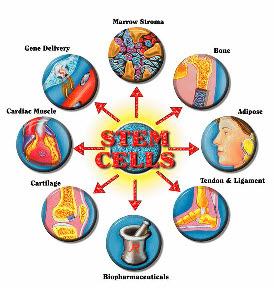

science
Please mouseover difficult words to see what they mean
News
CAMBRIDGE, Mass. Embargoed for release: 10-
Adult stem cells are different
Some people object to scientists doing research on stem cells taken from embryos. They insist that research into stem cells to cure disease can be done just as well on stem cells from adults.
Adult stem cells are very hard to harvest however. And new research from the Whitehead Institute for Biomedical Research in Cambridge, Mass has now shown that adult and embryonic stem cells are different in at least one very important way.
There is a certain protein that plays a major role in embryonic stem cells. Oct4
controls the genes that stop stem cells from becoming specialised into any of the
200 or so types of cell in the human body -
Researchers have long believed that Oct4 is also important in stopping adult stem cells from becoming specialised. Indeed more than 50 studies have reported finding that Oct4 is active in adult stem cells.
But those findings are misleading, according to research in the lab of Rudolf Jaenisch at the Whitehead Institute for Biomedical Research. The research is published online in Cell Stem Cells on October 10.
Postdoctoral fellow Christopher Lengner has shown that Oct4 is not needed to maintain adult stem cells in their undifferentiated state in mice. He has also shown that adult tissues work normally when no Oct4 is present.
Lengner used three independent methods to try to detect Oct4 in several tissue types in which other researchers had reported finding it. Either no trace of Oct4, or so little as to be indistinguishable from background readings, was found in all of these.
This is an important finding. It means that pluripotency is regulated differently in adult and embryonic stem cells. Pluripotency is the ability of stem cells to change into any kind of cell.
“This is the definitive survey of Oct4,” says Jaenisch, who is also an MIT professor of biology. “It puts all those claims of pluripotent adult stem cells into perspective.”
Oct4 maintains the pluripotency of embryonic stem cells. But only for a short time before the embryo implants in the wall of the uterus. After this Oct4 is turned off and the cells differentiate into over 200 cell types in the body.
“We have convincingly shown that Oct4 has no role in adult stem cells,” says Lengner.
The aim of the research was to find out how well tissues that had been shown to express Oct4 worked without the protein. These tissues included brain, bone marrow, hair follicle and the lining of the intestine.
To study this, Lengner bred mice in which the Oct4 gene had been deleted from a given tissue type. Next he stressed the tissue in several ways. This forced the adult stem cells within to regenerate the tissue. All of them regenerated normally.
Lengner and his colleagues then tested to make sure that Oct4 had indeed been deleted from the cells.
Finally they set out to validate the published reports that claimed Oct4 was expressed in these types of adult stem cell. Using highly sensitive methods that could detect Oct4 at the single cell level, they were unable to confirm the earlier reports.
“This is a cautionary tale of believing what you read in the literature,” says Lengner. He suggests that earlier studies might have misapplied tricky techniques. Or they could have worked with cell cultures that had spent too much time in an incubator.
“We now know that adult stem cells regulate their pluripotency, or ‘stemness’, using different mechanisms from embryonic stem cells, he says. He and his colleagues are now studying these mechanisms.
Is there one pathway that controls stemness in different adult stem cells, Lengner
wonders -
"We don’t yet know.”
“Oct4 is dispensable for somatic stem cell self-
Christopher J. Lengner(1), Fernando D. Camargo(1), Konrad Hochedlinger(3), G. Grant Welstead(1), Samir Zaidi(2), Sumita Gokhale(1), Hans R. Scholer(4), Alexey Tomilin(5) and Rudolf Jaenisch(1)(2)
More help with words
cell
embryo
confirm
inherit
conception
sperm
What's it all about?
Learning and teaching resources
The Genetics Science Learning Center at Utah University is an excellent source of
classroom resources and activities for teachers -
There is for example a nice webquest on stem cell at http://web.mit.edu/biology/www/
while an activity that probes students' positions on stem cell research and calls
for them to explain their reasoning can be found at http://learn.genetics.utah.edu/units/stemcells/print-
Click here for the full list of teacher resources at the Genetics Science Learning Center.
Teachers’ Domain also has a wealth of classroom resources and activities on stem cells. Again simple registration is required.
